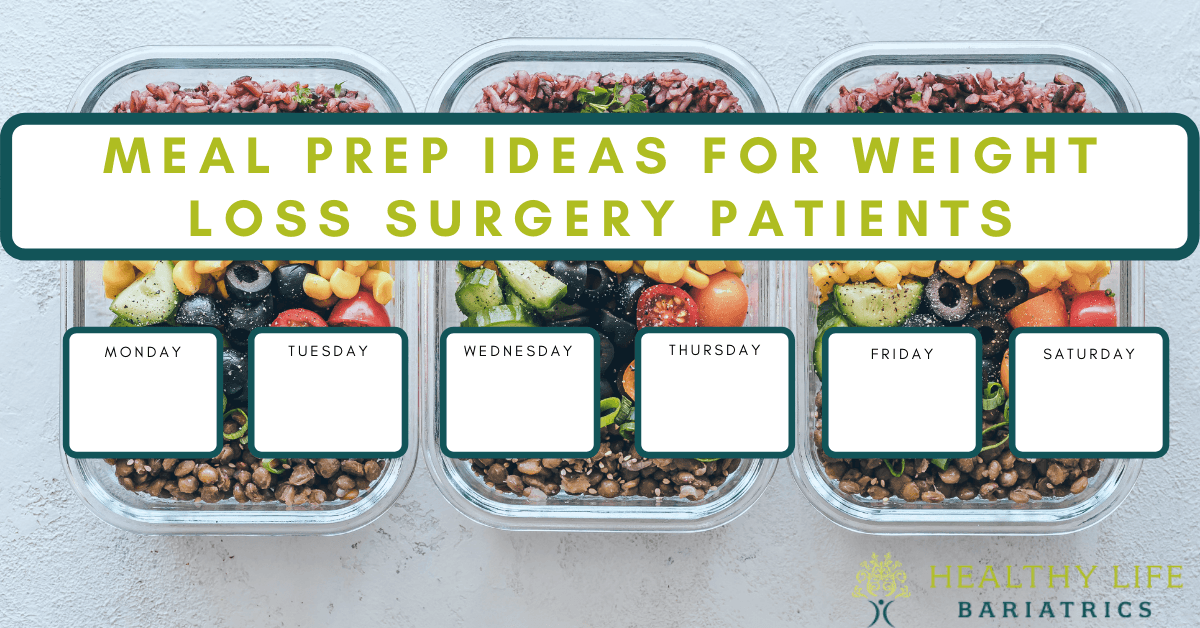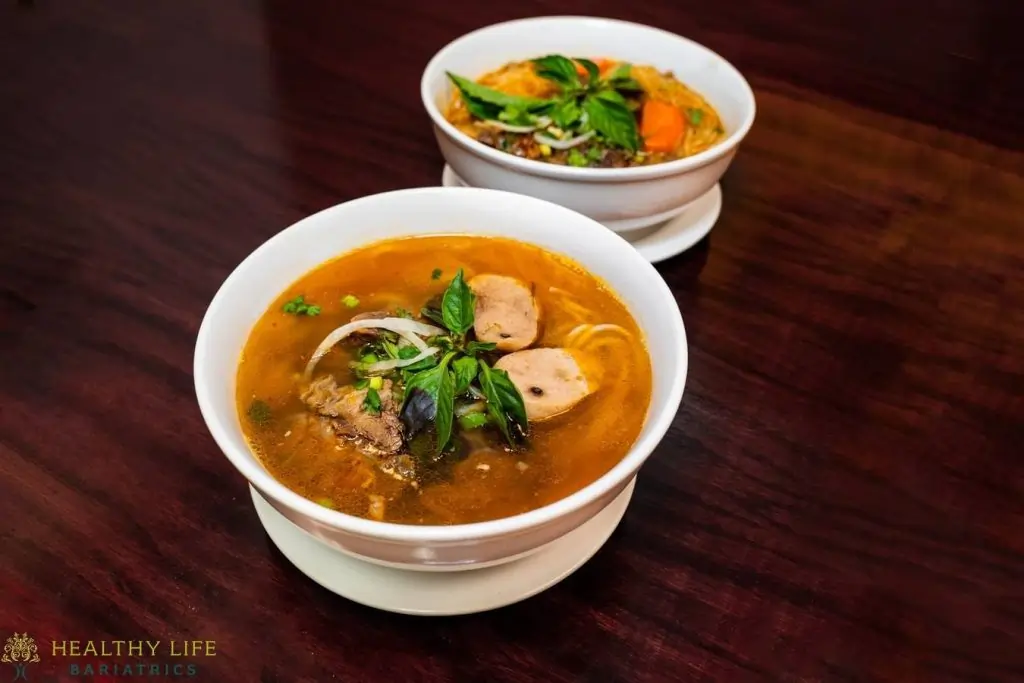
Meal prepping is the act of preparing healthy meals ahead of time. Weight loss surgery lets you control the foods you eat and the portions you consume.
Weight loss surgery requires good food choices to maximize weight loss. Meal prepping is an excellent way to introduce healthy eating and stay on track.
One of the biggest traps we fall into as humans is reaching for the “wrong foods” whenever we feel hungry. They always tell you not to grocery shop hungry for the same reason. When you’re starved, you’re more likely to reach for sugary and fatty foods. Like chips, candy, and other snacks. You know, the foods that give us the most calories in the least number of servings.
Eating like that is a prime way to gain weight. For bariatric surgery patients, reaching for any old food is a recipe ripe for weight regain.
Don’t undo all your hard work! Meal prep instead to save headaches and time. Meal prepping can also help you take control of the calories and nutrients you consume.
You don’t have to be a master chef to become a skilled meal prepper. Nor do you have to drop a couple hundred on groceries. With the right and most frugal steps, you can succeed at putting together some tasty and convenient meals. Here are some meal prep ideas to consider.
The liquid diet stage is the same for all bariatric surgeries. Whether you had the gastric sleeve, gastric bypass, or lap band, you will consume a pure liquid diet for a few weeks. The liquid diet hydrates you and lets your body adjust to the changes put in place by your bariatric surgeon.
The gastric sleeve and gastric bypass reduce the area for food inside your stomach to a small pouch. With the lap band, a gastric banding device wraps around your stomach. This has the same effect, reducing the surface area inside your stomach.
All three surgeries result in eating less food, though your body will take some time to adjust to these changes. The liquid diet allows you to reintroduce nutrients gradually and comfortably over time.

Choose your favorite liquid-based soup and add a half-cup of tomato juice. Then, store the soups in plasticware. That way, they are ready to go the next time you need a protein-rich, no-brainer lunch. Good liquid soups include bouillon, clear broth, and pureed vegetable soups.
Nuke the bowl of your favorite soup in the microwave for a minute or a minute-and-a-half or until hot enough to eat.
You don’t have to order sugary coffee drinks to enjoy a tasty pick-me-up. This protein shake will give you much-needed nutrients while satisfying your sweet tooth.
Mix four ounces of milk with four ounces of decaffeinated coffee. Add one scoop of vanilla or chocolate protein powder (your choice) and serve over ice.
After the liquid diet stage, you will introduce solid foods with a pureed texture. Over the next few weeks, you will build your body’s tolerance for even more solid foods.
When planning your meals during the “soft diet” phase, focus on protein-rich meals. Protein helps you build and maintain muscle mass, which helps you burn more calories at rest. Protein-rich foods also keep your hair, skin, and nails strong.
Consider these delicious, puree meal prep ideas.
For the puree stage, you can store containers of high-protein foods. Examples might include refried beans, Greek yogurt, pureed seafood, moist meats, and Tofu. Be sure to avoid red meat, fruits, vegetables, and starches. That includes rice, pasta, bread, cereal, oatmeal, fried foods, and fat/sugar-free puddings.
Mix ¼ cup of canned chicken, 1-½ tablespoons of tomato sauce, 1/8 teaspoon of salt, 1/8 teaspoon of pepper, and one teaspoon of Italian seasoning for this tasty lunch or dinner recipe. Place the mixture into a blender and blend to a soft texture. Microwave the mixture for thirty seconds. You can also add low-fat ricotta cheese or low-fat cottage cheese if desired.

After seven weeks, you will be able to begin your post-surgery diet. This is the regular diet you will follow indefinitely. Continue to prioritize protein for each of your meals. This is your chance to introduce more diverse foods into your menu, so have fun with it.
You can also get creative. Use the food categories below to develop your favorite meal ideas.
Whole milk is best to drink after bariatric surgery since it tends to be nutrient-dense. Lactose-free alternatives are also approved on a post-bariatric diet. Keep milk on hand to add to cereals, soups, and eggs for added nutrition.
Stick with cooked cereals like Cream of Wheat. You can also eat whole grains like brown rice, quinoa, hummus, flour, and rice cereal.
Greek yogurt and regular yogurt add taste to bland meals. They are also tasty all on their own. Cottage cheese is another simple food staple that goes down easy.
Try to fill your protein allotment first when preparing your post-bariatric meals. Choose protein from a variety of sources. Examples include low-fat dairy, eggs, lean meats, fish, seafood, and high plant sources. Soybeans and lentils are excellent plant-based sources of dietary protein.
Introducing large quantities of fruits and veggies after surgery can be difficult. Your limited stomach space makes you picky about what you eat, and protein usually wins out.
Keep in mind that any amount of produce is better than none at all. A few slices of cucumber or bell pepper to your cottage cheese or a few roasted broccoli florets to accompany your chicken breast can add a nice nutritional touch to any meal.
For a sweet treat, you can also try frozen berries in your cottage cheese or Greek yogurt.
Adding healthy fats to your meals is a good thing. Your body needs good fats like those found in animal and plant products. Examples include the fats in olives, olive oil, and avocados.
Consuming fat helps with hormone synthesis and the absorption of certain vitamins. Not all fat is created equal, so be mindful when adding a fat garnish like nuts or nut butter.

Get a set of plastic wear with compartments to fill them with your protein, produce, and grains of choice. Use measuring cups and spoons to control the volume of food you add to your dishes, and make sure you choose small containers whenever possible.
Choose small containers when storing your meals. While you’re at it, choose smaller plates, glasses, and bowls when eating and drinking. This tricks your brain into thinking the food is more substantial than it is.
With oversized plates and bowls, you might feel deprived. Stock your cabinets with smaller plasticware and glassware instead to take advantage of this handy and more satisfying optical illusion.
It would be best to talk to your bariatric surgeon before introducing new foods to your diet. These meal suggestions are not intended as dietary advice but to spark new ideas. Work with your surgeon, who may refer you to a dietician as part of your bariatric treatment plan. By speaking with professionals, you are bound to come up with a wide range of meal ideas you love.

One of the biggest obstacles to meal prepping is eating out. It isn’t easy to bring a prepared meal to a sit-down restaurant, particularly when seated with others ordering from the menu. You don’t have to fall off the wagon when eating out, nor do you have to bring your food.
Find a food establishment that offers healthy alternatives to keep from overindulging when eating out. Order as plainly as you can. In other words, stick to whole foods instead of mixtures of foods with many ingredients. Focus on protein first and consider splitting a meal with someone else since today’s restaurant food portions tend to be hefty.
The occasional treat of eating out does not have to be lost to you forever. You have to plan and coordinate properly to continue eating healthy. You can call it meal prepping for eating out if you will.
The most difficult aspect of meal prep is getting started. To spur yourself on, gather up all the containers you will need. Pick a day, such as Sunday, and prepare all your weekly meals. Take pleasure in creating breakfast, lunch, and dinner menu items.
With your meals all ready, keep these handy in the fridge and pantry. That way, you only have to reach for them to enjoy them.
Remember to use small containers and to choose a combination of nutrient-rich foods while giving protein center stage.
The most important thing to remember is that you are using meal prep to build new habits. You are learning to eat healthier. Enjoy the process of creating new meal ideas and watch the excess pounds melt away.
If you are considering weight loss surgery, speak to an expert. Dr. Babak Moeinolmolki of Healthy Life Bariatrics can help determine if weight loss surgery is right for you. Call (310)861-4093.